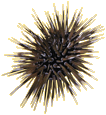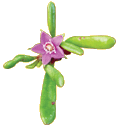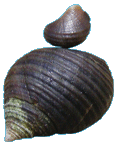 |
||||||||

Original art, Tampa Bay Crab Networking, by Sigrid Tidmore. www.sigridtidmore.com
 Thousands of years ago, when the Tocobaga Indians and other tribes lived in the Tampa Bay region, they dined like kings. There was so much to eat, and so easily gathered, that the tribes flourished – that is, until the Europeans arrived.
Thousands of years ago, when the Tocobaga Indians and other tribes lived in the Tampa Bay region, they dined like kings. There was so much to eat, and so easily gathered, that the tribes flourished – that is, until the Europeans arrived.
The remains of the shellfish, crabs, and such were discarded outside the village, forming huge mounds — we call them “Indian mounds” — and you can still find them today.
In modern time, the foods the Tocobagas enjoyed are a bit more limited and controlled. But you can still spend an enjoyable day getting most of the same foods, creating a family meal without costly equipment. And if you’re 16 or under, you don’t even need a permit to do it. Considering the price of seafood today, it’s a great way to extend the family food budget and enjoy fresh air and sunshine at the same time.
 Coquina soup
Coquina soup
Coquinas are just tiny clams with brightly colored shells, and you’ll find them all along the gulf beaches. Just dig a shallow hole with your hands at the swash line — where the waves lap onto the sand — and scoop them up into a kitchen colander. Sieve off the sand in the waves, and put them into a bucket with enough seawater to cover them. When you have about a quart of coquinas, you have enough to make soup for the family.
It’s a seafood broth. When you get your coquinas home, rinse them thoroughly under tap water, then put them in a soup pot, covering them with a few inches of water. Bring to a boil. The shells will open, and when you stir the pot you’ll see small bits of coquina meat. Turn off the heat, use a tea strainer to sieve out the coquina bits, and set them aside. Next, strain the broth and shells through a colander. Add the coquina bits back into the broth, and serve in soup bowls with a dollop of butter and a sprinkle of pepper. (You may want to save and dry the shells. Glued to a picture frame, they make a colorful gift — think your grandma’s Christmas present.)
 Sea Urchin al limon
Sea Urchin al limon
Sea urchins are those spiny creatures, about the size of your hand, that you often see when snorkeling in shallow water. They are tasty critters. They can be handled with bare hands, gently, but it’s best to wear gloves, and carry a net bag to put them in — a potato sack works well. The ones with short spines are legal to take, up to five per person per day, but the ones with long bristly spines are protected.
With a knife, cut the urchin in half, top to bottom. The yellow parts are what you want. Dash with lemon, and spoon them out. Scrumptious. Here’s a video — one of many — that demonstrates preparation. Accompaniments could be soy sauce with a bit of wasabi mustard, but I think a spritz of lemon is all that’s needed. http://www.youtube.com/watch?v=bI6bquY21I0&NR=1
 Sea purslane
Sea purslane
Sea Purslane is a low-growing plant that abounds along the shores of our bays and gulf waters. It has long runners along the sand, with reddish stems, small pink flowers and oblong green leaves. The leaves are what you want. Just pick them off and put in a container. For a nice addition to a salad, a handful per person is enough. For a veggie side dish, you’ll want about five times as much leaves.
It’s simple: pick the leaves, take them home, and rinse in tap water to remove any sand. Add a handful to any salad greens you have. They’re crunchy and tasty and mineral-rich. OR, if you have enough, put them in a pot to boil, briefly, then drain and serve with butter and lemon.
Catch of the day
Around any dock, pier or bridge, fish abound. Except for saltwater catfish, most all are good eating. Indians didn’t need a $1,000 rod and reel, and neither do you — just a length of line, a hook, and some bait, like shrimp or minnow, but even bacon will work. Use heavy-duty nylon line because you aren’t doing this for sport but for food — you want to yank the fish out of the water and into your cooler with a minimum of fuss. Wear leather gloves to protect your hands, and have some pliers to remove the hook from the fish’s jaw.
I could fill a book with this part, and many author-chefs have. Baked, grilled, broiled, sautéed, smoked, with or without marinade. The video link will open the door to many ways of dealing with fish. They’re all delicious. BUT, they involve sharp knives, so adult supervision is needed. http://www.youtube.com/watch?v=R5zJ8z-_1C4
Crab au natural
Florida Crackers know, as the Tocobaga did, there are few things as wonderful as a mess of fresh blue crabs for dinner. There are three easy ways to get them. (a) Find a patch of mangroves. Tie a raw chicken neck to a length of string, and toss it out into the water. Wait till you feel a good tug, then slowly — slowly — draw in the string. When the crab is just visible, scoop it up with a crab net or landing net (available at most bait/tackle shops) and dump it into a cooler. Don’t let the crab get too close to the surface before you scoop, or he’ll let go and retreat. (b) Rent a canoe or rowboat, and paddle to the mangroves, then use the same string/bait technique to catch the crabs. (c) My favorite and quickest way is to go wading in the mangrove channels at low tide, with crab net at the ready and a wash-tub tied to my shorts, floating behind me. Spot a crab, use the long-handled crab net to scoop him into the wash-tub. You can take up to ten gallons of crabs per person per day, which is more than enough to make dinner for a family.
There many ways to deal with crabs, but here’s the Florida Cracker way. Put a large kettle on the stove, fill two-thirds with water and bring to a rolling boil. Toss in a couple scoops of Old Bay seasoning. Using long-handle tongs, place — don’t dump, or you may get splashed with hot water — the crabs in the kettle, three or four at a time. When their shells turn bright red, they’re done. Remove them into a sink filled with cold water. Repeat until you have no more crabs.
Note: Commercial crabbers use mesh traps with floating buoys to mark them. DO NOT steal from those traps. It’s a prosecutable offense, and if a crabber catches you he will be very unpleasant.
Note: Male crabs are fine to take, but put the females back. Male crabs can mate multiple times, but females only about once a year. You can tell them apart by their bottom plates. The male has a “flap” plate shaped like a rocket on the launching pad, while the female has a dome-shaped flap. Another sign is if the crab has a cluster of orange stuff on the underside — those are crab eggs, waiting to hatch. Always, always return females to water, so we’ll have crabs to catch in the future.
Note: Whenever wading in bay waters, wear shoes. Cheap hi-top sneakers from a discount store are just fine; you’re out for food, not a fashion show.
Once the crabs are cool, you'll need to clean them before they are served. Twist off the claws and set aside in a bowl. Twist off the flipper legs and discard. With your fingers, open the bottom flap plate, and remove. Now, grasping the body of the crab, pry apart the carapace from the body. Under tap water, remove the grayish, feathery gills, the mouth parts, and scoop out the innards. Next, break the body in half, it’s easy to do—just hold it with your thumbs at the center bottom plate, and snap.
Now, it’s time to serve. You’ve got this big bowl of crab, and hungry mouths to feed. But it can get messy. Cover your dining table with two layers of newspaper. Provide nutcrackers — the metal ones, not the wooden ones from the Christmas muscial – and picks or cocktail forks. If you don’t have nutcrackers, pliers will work. Each diner needs a small bowl of garlic butter for dipping. Slices of lemon are good, too. A side salad, and some Cuban garlic toast complete the meal
For other ideas, here’s a video link that includes all kinds of options. I’ve had all kinds of crabs around the world — Dungeness, King, Snow and more — but the very best is our own native Florida blue crab. Beware, this video link can lead to hours of exploring the wonderful world of crabs. http://www.youtube.com/watch?v=QzUY7Z4t5Ps
|
Buzz Kelly is a Tampa native, sailor and freelance writer.

 Don't be
Don't be